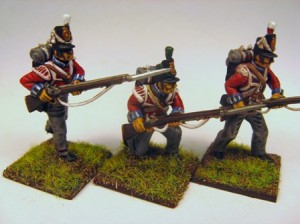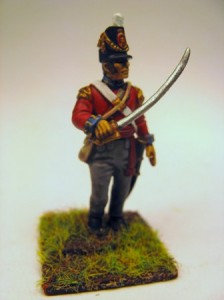It’s been some time since my last blog on the subject of Napoleonics but I have been busy painting and my Army is steadily growing, along with my knowledge of the period. My main reference in building my army has been the superb book, the Waterloo Companion by Mark Adkin. It really is a first class reference book and if you are at all interested in the period, I suggest that you must add it to your library!
The main fighting unit of infantry in the British Napoleonic army was the Battalion. You will often hear people refer to various Regiments when talking of the units at a particular battle , for example, the 27th Inniskilling Regiment. However, the Regiment in the British army was more of an organisational title and it was the battalion that actually took to the field. Some Regiments consisted of more than one Battalion; two or three were possible, but it was unlikely that there would be more (There were of course exceptions). In this case, the battalions would be numbered, so the first battalion of the 27th Regiment would be noted as 1/27, the second, 2/27 and so on.
A battalion consisted of around 800 men when at full strength. In reality, it was extremely rare for a Battalion to be at full strength whilst on campaign. The actual numbers varied from just over 700 to as few as 500. At the Battle of Waterloo, some battalions were below this number, due to casualties suffered at the battle of Quatre Bras. Regardless of numbers, the battalion was divided into 10 Companies, each usually commanded by a Captain. Eight of the Companies would be known as Line or Centre Companies and would be numbered 2 to 9. The other two Companies were the Flank Companies. Company number one, deployed on the right of the line was the ‘Grenadier Company’ and usually formed from the biggest & bravest soldiers. Company number 10, was the Light Company and whilst usually deployed on the left of the line was also used as the skirmishers for the Battalion. These troops were usually the best shots and the smallest and fastest in the Battalion. They were often deployed well in advance of the battalion and if trouble threatened, they needed to be able to get back to their lines quickly!
Flank Companies were distinguished from the Centre Companies by the size of their Epaulets and the colour of the plumes on their Shako’s. Flank Companies have the big ‘wing’ type epaulets ( first two models on the left of the pic.) as opposed to the’ tufts’ of the Centre company’s and the Grenadier Company would have all white plumes whilst the Light company would have green plumes. In addition, the officers in the Flank Companies tended to carry a Curved Sword or sabre as oppose to a straight one.
So having blathered on long enough about the technicalities of Flank Company troops I’ll show you in the next article how I put mine together.



